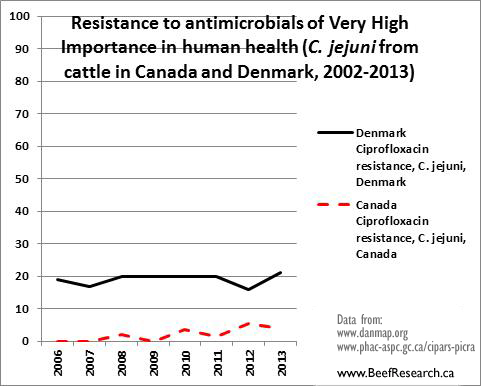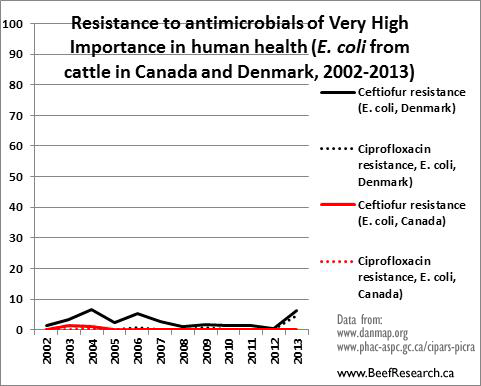Antimicrobial resistance has become a highly charged issue. Headlines appear in the news on a regular basis suggesting that antibiotics are becoming less effective in humans and farmers are to blame.
Some concerns have been raised that antimicrobial use in livestock leads to antimicrobial resistance and that some of the products used in food animals are closely related to antimicrobials that are important in human health. It’s also been questioned whether antimicrobial resistance can be transferred among bacteria, which may reduce effectiveness of drugs used in human medicine.
Of course the Canadian beef industry is also concerned about antimicrobial resistance. Cattlemen depend on the effectiveness of animal health products, and on consumers’ confidence in how beef is raised and the safety of the beef they consume. And just like the rest of the society, farmers need human drugs to be effective too.
We’re all in agreement on the seriousness of antimicrobial use and resistance.
Several nations around the world have surveillance programs in place to monitor trends in antimicrobial use and resistance. In Canada, this is led by the Canadian Integrated Program for Antimicrobial Resistance Surveillance (CIPARS). In the United States, surveillance is conducted by the National Antimicrobial Resistance Monitoring System (NARMS). These programs test for antimicrobial resistance in healthy animals arriving at slaughter plants as well as retail meat samples. In addition, various groups including the Beef Cattle Research Council and Agriculture and Agri-Food Canada collect more detailed antimicrobial use and resistance information in a broader range of microbes and locations (e.g. feedlots, manure, soil, water).

To date, scientific surveillance has indicated that:
- Resistance to antimicrobials that are most important in human health is extremely uncommon in healthy North American cattle and beef.
- Multi-drug resistance is similarly low, and is not increasing.
- In cattle, the vast majority of antimicrobials used are not used in human health at all.
Let’s look more closely at the last point. The vast majority of antimicrobials used in cattle are ionophores. Ionophores act on rumen microbes; they selectively inhibit methanogenic bacteria and allow beneficial rumen bacteria to make more feed energy available to the animal, thereby improving feed efficiency and weight gain. Ionophores also prevent diseases like coccidiosis.
Ionophores have no benefit to, nor are they licensed for use in humans. Even if microbes developed resistance to ionophores, this would not make them resistant to classes of antimicrobials that are used in human medicine.
Eliminating antimicrobial growth promotants, including ionophores, in cattle production would substantially reduce the overall use of antimicrobials, but would that reduce concerns about antimicrobial resistance?

Denmark phased out the use of those products in livestock production between 1994 and 1999. Since 2001, we can see a clear trend of increased use of prescribed veterinary antimicrobials. The decrease in antimicrobial use has happened in the “medium importance” category, antimicrobials rarely used in human medicine anymore. Without the use of growth promoting antimicrobials, the need for antimicrobials that are important to human health increased. In addition, there has been no clear trend towards decreased antimicrobial resistance in Danish cattle or beef (see graphs below).
Canadian research has repeatedly shown that antimicrobials are used responsibly by Canadian beef producers, and resistance to the most important classes of antibiotics in human medicine remains extremely rare in beef cattle. Antimicrobial resistance will continue to be a research priority in Canada’s beef industry to maintain or improve current prudence.
Continued use of antimicrobials of no importance to human health in Canadian beef production will be critical to the future competitiveness of and reduced environmental impacts by Canada’s beef sector due to improved feed efficiency and reduced animal disease. Furthermore, the consequences of a ban on ionophores in Denmark suggest that discontinuing the use of such products would not lead to lower antimicrobial resistance, and may increase the use of antimicrobials that are important in human medicine.
To learn more about antimicrobial use and resistance in Canadian cattle and beef, including a 7-minute video for producers, visit www.beefresearch.ca/AMR
Click here to subscribe to the BCRC Blog and receive email notifications when new content is posted.
The sharing or reprinting of BCRC Blog articles is welcome and encouraged. Please provide acknowledgement to the Beef Cattle Research Council, list the website address, www.BeefResearch.ca, and let us know you chose to share the article by emailing us at info@beefresearch.ca.
We welcome your questions, comments and suggestions. Contact us directly or generate public discussion by posting your thoughts below.








